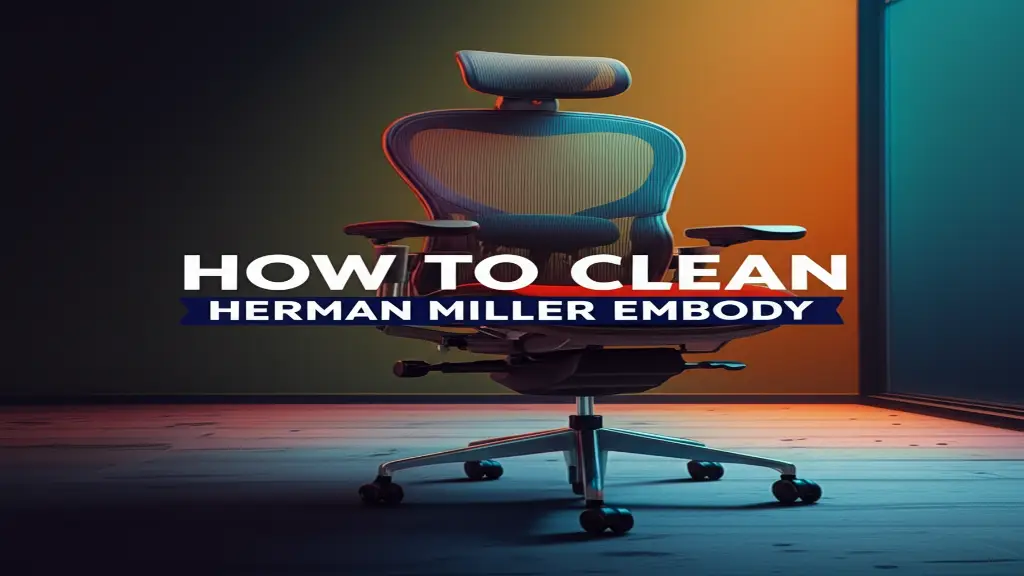· Furniture Care · 16 min read
How To Clean Herman Miller Embody

How To Clean Herman Miller Embody: A Simple Guide
Your Herman Miller Embody chair is an important part of your workspace. It provides comfort and support for long hours. This chair is an investment in your well-being. Keeping it clean ensures its longevity and maintains its appearance. Knowing how to clean Herman Miller Embody chairs correctly protects your investment.
This guide helps you understand proper cleaning methods. We will cover routine maintenance. We will also look at deep cleaning steps. You will learn about the right tools and products to use. This information helps your Embody chair look new for many years.
Takeaway
- Identify your Embody chair’s materials before cleaning.
- Gather gentle cleaning tools: vacuum, microfiber cloths, mild soap, water.
- Perform regular dusting to prevent dirt buildup.
- Spot clean fabric with mild soap and water, testing first.
- Wipe down the frame and hard surfaces regularly.
- Address spills immediately to prevent permanent stains.
- Ensure the chair dries completely to avoid issues.
- Follow Herman Miller’s specific cleaning instructions for best results.
Concise Answer
To clean your Herman Miller Embody chair, identify its materials first. Use a vacuum for dust. Spot clean fabric with mild soap and water. Wipe plastic parts with a damp cloth. Always dry the chair completely to maintain its look and function.
Understanding Your Embody Chair’s Materials
Your Herman Miller Embody chair uses specific materials. These materials help create its unique support system. Knowing what your chair is made of helps you choose the right cleaning method. Different materials need different care. Using the wrong cleaner can cause damage.
Most Embody chairs have a combination of materials. The back and seat often feature a “pixelated support” structure. This structure is covered with a textile. Herman Miller offers various fabric options. These fabrics include Rhythm, Balance, Medley, and Sync. Each fabric type has unique properties. Some are more breathable. Others feel softer. The chair frame is mostly plastic. This includes the armrests, base, and structural components. Some base options might be polished aluminum.
Before you clean, look at your specific chair’s specifications. You can find this information on the Herman Miller website. Checking your chair’s details helps you understand its exact fabric type. This knowledge guides your cleaning choices. It ensures you use safe and effective methods. Proper material identification prevents costly mistakes.
I always check my chair’s label or documentation first. This small step saves me from potential problems. For example, some fabrics react differently to water. Some cleaners are too harsh for certain plastics. Gentle care is always best for these high-quality materials. Taking the time to understand your chair protects its value and appearance.
Gathering Your Cleaning Tools
Having the right tools makes cleaning your Embody chair easy. You do not need many special items. Most of these tools are already in your home. Using the correct tools prevents damage to your chair. It also helps you clean more effectively.
Here is a list of essential cleaning tools:
- Vacuum cleaner with brush attachment: This removes loose dirt and dust. The brush attachment helps lift debris from fabric fibers. A handheld vacuum works well for quick clean-ups.
- Microfiber cloths: These cloths are soft and absorbent. They do not leave lint behind. You will need several for wiping and drying.
- Mild liquid soap: Use a gentle, pH-neutral soap. Dish soap without strong additives often works well. Avoid harsh detergents or abrasive cleaners. Herman Miller recommends a mild soap solution.
- Two buckets or bowls: One for soapy water, one for clean rinse water. This keeps your cleaning process tidy.
- Spray bottle (optional): A spray bottle helps apply cleaning solution evenly. It prevents over-wetting the fabric.
- Soft brush (optional): A very soft brush can help gently agitate stubborn spots on fabric. Be careful not to scrub too hard.
Avoid using harsh chemicals like bleach or ammonia. These can damage the fabric and plastic. They can also strip away protective finishes. Do not use abrasive pads or scrub brushes. These can scratch or scuff surfaces. Always choose tools that are gentle on your chair’s materials.
I keep a small cleaning kit ready for my Embody chair. This way, I can tackle spills right away. Quick action often prevents stains from setting. Having the right tools on hand makes maintenance simple.
Regular Dusting and Light Cleaning
Regular cleaning prevents dirt from building up. This keeps your Embody chair looking fresh. It also helps maintain the chair’s breathable features. Dust and debris can get into the fabric and mechanisms. A simple routine saves you from needing deep cleans often.
Start with your vacuum cleaner. Use a soft brush attachment. Gently vacuum the entire chair. Pay close attention to the seat and backrest. Dust collects in the fabric weave. Move the attachment slowly over all surfaces. Get into the crevices and seams. Vacuum the armrests and the base too. Loose dust and crumbs come off easily with vacuuming.
After vacuuming, use a clean, dry microfiber cloth. Wipe down all hard surfaces. This includes the plastic frame, armrests, and the base. A dry cloth removes any remaining surface dust. You can also use a slightly damp cloth for a quick wipe. If using a damp cloth, ensure it is only lightly moist. Do not saturate any part of the chair.
This routine takes only a few minutes. I try to do this once a week. This keeps the chair from ever looking dirty. It also prevents allergens from accumulating. Regular care protects the fabric and plastic from daily wear. It makes your deeper cleaning tasks much easier when they are needed.
Think of it like dusting your furniture. A little effort often prevents a big job later. Consistent light cleaning keeps your Herman Miller Embody chair in top condition.
Deep Cleaning the Fabric
Over time, even with regular dusting, your chair’s fabric may need a deeper clean. Spills and body oils can cause discoloration. Deep cleaning revives the fabric’s appearance. It also removes deeper grime. Always test your cleaning solution on a hidden area first. This ensures no color changes or damage will occur.
First, mix your cleaning solution. Use a mild liquid soap and cool water. A few drops of soap in a bucket of water are usually enough. The solution should be foamy, not overly soapy. Dampen a clean microfiber cloth with this solution. Wring out the cloth very well. It should be damp, not wet.
Now, gently blot the fabric. Do not rub or scrub vigorously. Blotting lifts the dirt from the fibers. Work in small sections. For general grime, gently wipe the entire fabric surface. For specific spots, focus on those areas. Apply light pressure. Rinse your cloth often in clean water. Re-dampen it with the soapy solution as needed.
After cleaning with soap, use a second clean microfiber cloth. Dampen this cloth with plain cool water. Wring it out very well. Blot the cleaned areas again. This step removes any soap residue. Soap left on the fabric can attract new dirt. Repeat this rinsing step until all soap is gone.
For stubborn spots, you might need more attention. Act quickly on spills. Many stains come out if you treat them fast. If you have specific stains, knowing how to approach them helps. For example, some general principles for removing stains from surfaces can be applied to fabric, with caution. Learning how to clean stains off walls teaches you about different stain types and methods, which can give you ideas for tackling chair stains. Always prioritize Herman Miller’s specific care instructions.
After cleaning, allow the fabric to air dry completely. Use a fan to speed up drying if needed. Do not use heat, like a hairdryer, on the fabric. Heat can damage the fibers. Ensure the chair is fully dry before you sit on it. This prevents mildew and odors.
Cleaning the Frame and Hard Surfaces
The plastic frame and hard surfaces of your Embody chair also need cleaning. These parts can collect dust, fingerprints, and smudges. Regular cleaning keeps them looking new. It also maintains the chair’s overall hygiene. The process for these areas is simpler than for fabric.
Start by wiping down all hard plastic surfaces. Use a clean microfiber cloth. You can dampen the cloth with plain water for most daily cleaning. Wipe the armrests, the chair base, and the back supports. Get into the crevices where dust might settle. These areas are often touched, so they can get dirty quickly.
For more stubborn marks or a deeper clean, prepare a mild soap solution. Use the same mild liquid soap you would for fabric. Mix a few drops with cool water in a bowl. Dampen a clean microfiber cloth with this solution. Wring out the cloth very well. The cloth should be just damp. Gently wipe all plastic and hard surfaces with this cloth.
After cleaning with soap, use a fresh microfiber cloth dampened with plain water. Wipe the surfaces again. This removes any soap residue. Soap left behind can leave a sticky film. Make sure all parts are free of suds.
Sometimes, people consider alternative gentle cleaners. For example, some people use diluted vinegar solutions for cleaning various surfaces. Understanding how to clean walls with vinegar can give you ideas about using vinegar as a general cleaner. However, for your Embody chair, Herman Miller strongly recommends mild soap and water. Stick to their guidelines. Only use vinegar or other alternative cleaners if you are absolutely sure they are safe for the specific plastic and metal finishes on your chair. Always test a small, hidden area first.
Once you finish cleaning, dry all hard surfaces immediately. Use a clean, dry microfiber cloth. Do not let water sit on the plastic or metal. Water spots can form. Proper drying ensures a streak-free finish. This step keeps your chair looking its best.
Addressing Specific Issues: Spills and Stains
Spills happen. When they do, acting fast is the key. Quick action often prevents a spill from becoming a permanent stain. Different types of spills need slightly different approaches. Knowing what to do can save your chair’s appearance.
For liquid spills, blot immediately. Use a clean, dry cloth or paper towel. Press down firmly to absorb as much liquid as possible. Do not rub the spill. Rubbing can spread the liquid and push it deeper into the fabric fibers. Continue blotting until no more liquid transfers to the cloth.
Once you have blotted the excess liquid, you can clean the remaining spot. Prepare a mild soap and water solution. Dampen a clean microfiber cloth with this solution. Wring it out very well. Gently blot the stained area. Work from the outside of the stain inwards. This stops the stain from spreading. Rinse your cloth in clean water often. Reapply the soap solution as needed.
For tougher stains like ink, oil, or food, the process might be harder. Ink stains are often tricky. Oil-based stains require a degreasing action. For food stains, scrape off any solid bits first. Then proceed with the blotting and cleaning solution. Always refer to Herman Miller’s specific care instructions for difficult stains. They might recommend specific stain removers safe for their fabrics. Never use harsh chemical cleaners unless approved by the manufacturer. These can damage the fabric and void your warranty.
After cleaning the stain, rinse the area with plain water. Use a clean, damp cloth. Blot to remove all soap residue. Then, dry the area completely. You can use a clean, dry towel to absorb moisture. Air drying is best for the final step. Make sure the spot is completely dry before sitting on the chair.
If you are dealing with very old stains or mold due to damp conditions, you might need stronger, yet safe, solutions. For example, if you ever had to clean mold with vinegar in a humid environment, you know how important proper ventilation is. For your Embody, prevention of mold is key. Keep the chair dry and in a well-ventilated area. If mold does appear, consult Herman Miller’s specific advice or a professional cleaner.
Drying and Final Touches
Proper drying is a critical step in cleaning your Herman Miller Embody chair. If you do not dry the chair completely, it can lead to problems. Wet fabric can develop mildew or unpleasant odors. It can also cause the internal components to rust or degrade. Thorough drying protects your chair’s health and longevity.
After you finish cleaning, gently blot any excess moisture from the fabric. Use a clean, dry towel or microfiber cloth. Press firmly to absorb as much water as possible. Do this over all cleaned fabric areas. For hard surfaces, wipe them dry immediately with a clean, dry cloth.
Now, allow the chair to air dry. This is the safest and most recommended method. Find a well-ventilated area for the chair. Open windows if you can. You can also place a fan nearby. Direct the fan towards the chair. This increases air circulation. Increased airflow helps the chair dry faster.
Do not use direct heat sources to dry your chair. Avoid using hair dryers, space heaters, or placing the chair in direct sunlight for long periods. High heat can damage the fabric fibers. It can also warp or discolor the plastic components. Air drying ensures a gentle and safe process.
It might take several hours for the chair to dry completely. The exact time depends on how much moisture you used. It also depends on the room’s humidity and airflow. Before using the chair, feel all fabric areas. They must be completely dry to the touch. Press down firmly to check for hidden dampness.
Once dry, your Embody chair is ready for use. It should look refreshed and clean. This final drying step ensures your cleaning efforts are successful. It prepares your chair for many more hours of comfortable use.
Preventive Care and Long-Term Maintenance
Caring for your Herman Miller Embody chair goes beyond cleaning. Preventive measures keep your chair in great shape for years. Long-term maintenance extends its lifespan. It also protects your investment. A little prevention saves a lot of cleaning effort later.
Here are some simple steps for preventive care:
- Avoid eating and drinking directly over the chair: Spills are the most common cause of stains. Using a mat or eating elsewhere prevents many accidents.
- Use a chair mat: A chair mat protects your floor. It also keeps your chair’s wheels clean. Clean wheels move smoothly. They also prevent tracking dirt onto the chair base.
- Keep pets away: Pet hair and dander can get embedded in the fabric. Pets might also scratch or chew on the chair.
- Position away from direct sunlight: UV rays from sunlight can fade fabric colors. They can also degrade plastic over time. Place your chair where it is not in constant direct sun.
- Maintain proper humidity: Very dry air can affect materials. Very humid air can encourage mold or mildew. Keep your room’s humidity at a moderate level.
- Address issues immediately: If you notice a loose screw or a strange sound, fix it or get it checked. Do not let small problems become big ones. Herman Miller chairs are built to last, but regular checks help.
Regular, light cleaning is your best defense. This prevents dirt from becoming ingrained. Wipe down surfaces weekly. Vacuum the fabric every few weeks. This consistent care keeps the chair looking new.
Think about how you use the chair daily. Are you leaning back often? Do you adjust the settings frequently? These actions can cause wear. Gentle use complements your cleaning efforts. Your Embody chair is designed for heavy use. But treating it well extends its peak performance. By combining good cleaning habits with smart preventive care, your Herman Miller Embody chair will serve you well for a very long time.
FAQ Section
Q1: How often should I clean my Herman Miller Embody chair? For light cleaning, dust and wipe down your chair weekly. Perform a more thorough deep clean of the fabric and frame every 3-6 months. This schedule depends on how much you use the chair. If you use it daily or eat at your desk, you might need to clean more often. Regular light cleaning prevents dirt buildup.
Q2: Can I use a steam cleaner on my Embody chair’s fabric? No, Herman Miller does not recommend steam cleaning for Embody fabrics. High heat and excessive moisture can damage the specific materials. They can also affect the chair’s internal components. Stick to mild soap and water solutions. This is safer for the fabric and the chair’s structure.
Q3: What should I do if a sticky residue is on the plastic frame? For sticky residue, mix a very dilute solution of mild soap and warm water. Dampen a microfiber cloth with this solution. Gently wipe the sticky area. You might need to repeat this several times. Avoid scrubbing vigorously. After removing the residue, wipe the area with a clean, damp cloth (water only). Dry it completely.
Q4: Is it safe to use rubbing alcohol for disinfection on my Embody chair? Herman Miller generally advises against using strong chemical cleaners or disinfectants like rubbing alcohol. These can degrade the plastic and fabric over time. For disinfection, a mild soap and water solution is often sufficient. If you need a stronger disinfectant, consult Herman Miller’s specific guidelines or contact their support.
Q5: My chair has a strong odor. How can I remove it? A strong odor often means moisture or trapped sweat. First, ensure the chair is completely dry. Use a fan to air it out for a day or two. For persistent odors, you can lightly mist the fabric with an odor eliminator designed for upholstery. Or, sprinkle baking soda on the fabric, let it sit for a few hours, then vacuum it thoroughly.
Q6: Can I remove the fabric covers for washing? No, the fabric covers on the Herman Miller Embody chair are not designed to be removed for washing. Attempting to remove them can damage the chair’s upholstery and support structure. Always clean the fabric while it is on the chair. Follow spot cleaning and gentle overall cleaning methods.
Conclusion
Keeping your Herman Miller Embody chair clean is simple with the right approach. This chair is a key piece of your workspace. Proper care protects its value and extends its life. You now know how to clean Herman Miller Embody chairs effectively. From regular dusting to deep cleaning fabrics and frames, each step helps.
Remember to identify your chair’s materials first. Gather gentle cleaning tools. Always test cleaning solutions in a hidden spot. Tackle spills quickly. Let the chair dry fully. By following these steps, you maintain your Embody chair’s appearance and comfort. It will continue to provide ergonomic support for many years. Regular cleaning is an investment in your chair’s future. It keeps your workspace clean and professional. Your Embody chair deserves this simple care.
- Herman Miller Embody cleaning
- Embody chair care
- office chair cleaning
- ergonomic chair maintenance
- fabric cleaning
- plastic furniture care




